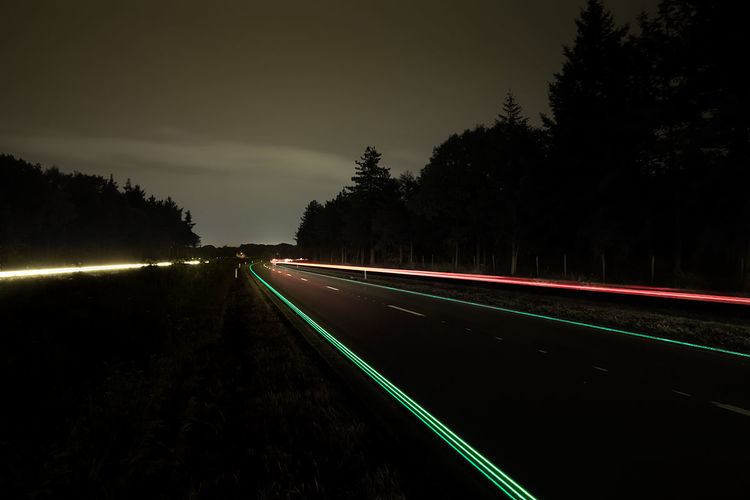 | ||
Smart highway and smart road are terms for a number of different proposals to incorporate technologies into roads for generating solar energy, for improving the operation of autonomous cars, for lighting, and for monitoring the condition of the road. The world's first photovoltaic road was under construction in Tourouvre, Orne, France in November-December 2016.
Contents
Intelligent transportation systems
Intelligent transportation systems usually refers to the use of information and communication technologies (rather than innovations in the construction of the roadway) in the field of road transport, including infrastructure, vehicles and users, and in traffic management and mobility management, as well as for interfaces with other modes of transport.
Photovoltaic pavement
Photovoltaic pavement is a form of pavement that generates electricity by collecting solar power with photovoltaics. Parking lots, foot paths, driveways, streets and highways are all candidate locations where this material could be used.
In 2013 Students at the Solar Institute at George Washington University installed a solar panel walking path designed by Onyx Solar, something they call solar pavement.
SolaRoad is a system being developed by the Netherlands Organisation for Applied Scientific Research (TNO), the Ooms Groep, Imtech and the Netherlands province of North Holland. They plan to install their panels on 100 m of cycle path in Krommenie, Netherlands in November 2014. A variant concept of a "solar road" installed in Avenhorn, by Ooms Avenhorn Holding AV, uses asphalt and tarmac to absorb the sun’s rays and heat water for use in domestic heating.
The Solar Roadways company of Idaho, USA, is developing a prototype system to replace current roads, parking lots, and driveways with photovoltaic solar road panels that generate electricity.
South Korea has built a freeway with the median covered by solar panels above a bikepath.
The first photovoltaic road in the world was constructed in Tourouvre, Orne, France in 2016. Called "Wattway", it was built by Société Nouvelle Aeracem (SNA), and dedicated by the French Minister of Ecology, Ségolène Royal on October 25, 2016. The 1-km section of road opened to traffic on 22 December 2016. It is believed the road will provide enough power for the town's streetlights.
Wireless vehicle charging
The Online Electric Vehicle being developed by KAIST (the Korea Advanced Institute of Science and Technology) has electrical circuits built into the road which will power suitably adapted vehicles via contactless electromagnetic induction. A pilot system powering electric buses is under development. Germany's IAV is another company that is developing induction chargers.
Road markings
The Smart Highway concept developed by Studio Roosegaarde and the infrastructure management group, Heijmans, of the Netherlands incorporated photo-luminescent paint for road markings, which absorb light during the day then glow for up to 10 hours. The technology was demonstrated on a stretch of highway in Brabant, Netherlands.
Frost protection and melting snow, ice
Snowmelt systems using electricity or hot water to heat roads and pavements have been installed in various locations.
Solar Roadways has proposed including a snowmelt system with their photovoltaic road panels since the panels already have electrical power connections for harvesting photovoltaic power. Skeptics point to the cost.
ICAX Limited of London's "Interseasonal Heat Capture" technology captures solar energy in thermal banks and releases it back under a roadway, heating it and keeping asphalt free of ice.
Benefits
In the U.S., a study found that between 1996-2011, over 12,000 deaths were caused by winter-related precipitation. Annually over 500,000 accidents occur because of winter-related weather. In 2014, federal, state, and local governments spent $73 billion on operation and maintenance of highways, including for resurfacing needed because of current snow removal techniques. Between October 2014-April 2015, 23 state DOTs reported spending $1.131 billion on snow and ice removal, including 8 million working hours, not including local expenditures. For instance, between 2003-2015, the city of New York estimated the cost of snow and ice removal at $1.8 million per inch. Annually, auto drivers lose $23.4 billion in corrosion-related repair costs and depreciation linked to chemicals used to treat roadways during winter. In 2014, economists estimated that snow and ice that winter had cost the country $47 billion in GDP and 76,000 jobs.
With snow and ice melt systems deployed to obstruct winter weather, deaths, accidents, governmental and insurance costs, economic losses, and personal auto expenditures are reduced.
